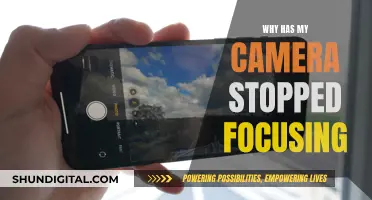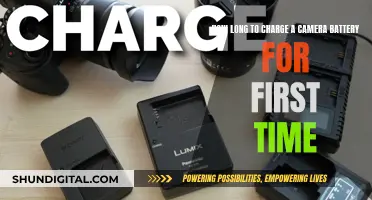
The history of cameras is a long and fascinating one, spanning centuries and involving numerous inventors and innovations. The evolution of cameras can be traced back to the camera obscura, a natural optical phenomenon where an inverted image is projected through a small aperture. This concept, first described by Han Chinese philosopher Mozi around 470 to 391 BC, laid the foundation for future advancements.
Over time, cameras evolved from large, room-sized devices that required multiple people to operate, to more compact and portable models. The first photographic camera, developed in 1816 by Joseph Nicéphore Niépce, used silver chloride-lined paper to create photographic images. However, it was Louis Daguerre who, in collaboration with Niépce, created the daguerreotype camera in 1839, which produced sharper images with shorter exposure times.
The daguerreotype camera paved the way for other significant inventions, such as the calotype process by William Henry Fox Talbot, which used paper negatives for mass reproduction. The introduction of flexible roll film by George Eastman in the 1880s revolutionized photography, making it accessible to amateurs. This led to the creation of iconic cameras like the Kodak and the Brownie, which became a household item.
The journey to colour photography involved experimentation with manually adding colours to daguerreotypes and tintypes. The first colour photograph was taken by James Clerk Maxwell in 1861. However, it was the introduction of Kodachrome by Eastman Kodak in 1935 that marked a significant breakthrough, making colour photography more accessible and practical.
The digital camera, first prototyped in 1975 by Steven Sasson of Eastman Kodak, revolutionized the market. Digital cameras offered convenience, high-resolution images, and instant results. Today, digital cameras and smartphone cameras have become the most popular and widely used types of cameras, with continuous advancements in technology.
| Characteristics | Values |
|---|---|
| First camera | Camera obscura |
| First camera inventor | Unknown, but the oldest written records are by Han Chinese scholar Mozi (c. 470 to c. 391 BC) |
| First permanent photograph | Taken in 1826 by Joseph Nicéphore Niépce |
| First photographic camera | Developed in 1816 by Joseph Nicéphore Niépce |
| First photographic camera for commercial manufacture | Daguerreotype camera, built by Alphonse Giroux in 1839 |
| First roll film | George Eastman created the first camera that used a single roll of celluloid emulsion film in 1888 |
| First 35mm film | Kodak introduced 135 film in 1934 |
| First instant camera | Invented by Edwin Land in 1948 |
| First digital camera | Invented by Steven Sasson in 1975 |
| First camera phone | Kyocera VP-210, developed in 1999 |
What You'll Learn
- The first cameras were large and required many people to operate them
- The camera obscura was the first camera ever created
- The daguerreotype camera was the first to produce permanent, replicable photographs
- Roll film cameras allowed multiple exposures on the same roll of film
- mm film cameras were portable and versatile

The first cameras were large and required many people to operate them
The first cameras were an evolution of the camera obscura, which was a dark room with a small hole that projected an inverted image of the outside scene onto the adjacent wall. This technique was used to safely view solar eclipses and later as a drawing aid. The camera obscura is thought to have been invented around 400 BC, with the oldest written records of the idea coming from Han Chinese scholar Mozi (c. 470 to c. 391 BC).
The first photographic camera was developed in 1816 by Joseph Nicéphore Niépce, a French inventor. However, the camera's origin relied on centuries of contributions. Niépce created photographic images on silver chloride-lined paper, and the oldest extant photograph is one he made around 1826. The original shot is still on exhibit at the University of Texas at Austin.
Niépce's camera was a sliding wooden box camera made by Parisian opticians Charles and Vincent Chevalier. He coated the plates with a type of asphalt and observed how they were impacted by sunshine, referring to his studies as "heliography" or "sun writing". The first photograph took eight hours of exposure time and showed the view from his window.
While Niépce is credited with creating the first permanent photograph, the images from his camera were unclear and lacked focus. It wasn't until he partnered with Louis-Jacques-Mandé Daguerre in 1829 that they were able to perfect the process and commercialize it. Unfortunately, Niépce died in 1833, before witnessing the enormous economic success Daguerre achieved by adapting his original design.
Daguerre invented a camera that could produce extraordinarily detailed pictures on a refined sheet of silver-plated copper sensitized with vaporized iodine. His camera and method became commercially successful almost immediately and were widely used because of their ability to produce images quickly and in great detail. Daguerreotypes became the standard for cameras in the mid-19th century.
Best Cameras for RAW Photography: Unlocking the Power
You may want to see also

The camera obscura was the first camera ever created
The camera obscura has a long history, dating back to ancient times. The earliest written record of this idea is found in the Chinese text "Mozi," dated to the 4th century BC. The text describes how light passing through a small aperture creates an inverted image, with the author attributing this phenomenon to light travelling in straight lines.
Over the centuries, the camera obscura was studied and used by various scholars and inventors, including the Greek philosopher Aristotle, the Arab physicist Ibn al-Haytham (Alhazen), and the Italian polymath Leonardo da Vinci. Da Vinci, in particular, wrote extensively about the camera obscura in his notebooks, experimenting with different shapes and sizes of apertures.
In the 16th and 17th centuries, the camera obscura became popular as an aid for drawing and painting. Artists and draughtsmen used it to capture accurate and detailed sketches of landscapes and architecture, especially to achieve proper graphical perspective. By the late 17th century, portable camera obscura devices in tents and boxes were commonly used.
The camera obscura played a crucial role in the development of photography. In the early 19th century, the French inventor Joseph Nicéphore Niépce used a camera obscura to capture the world's first permanent photograph in 1826. He created this photograph by exposing a bitumen-coated plate in a camera obscura for several hours, producing an image of a courtyard and outbuildings.
While the camera obscura itself does not capture or preserve images, it served as the foundation for the development of photographic cameras. By combining the camera obscura with light-sensitive materials, inventors like Niépce and Louis Daguerre created the first photographic cameras, marking the beginning of modern photography.
Charging Camera Batteries: Overcharging and Its Effects
You may want to see also

The daguerreotype camera was the first to produce permanent, replicable photographs
The process of capturing an image with a daguerreotype camera was complex and time-consuming. First, a sheet of silver-plated copper was polished to a mirror finish. The plate was then treated with fumes to make its surface light-sensitive. Next, the plate was placed in a camera and exposed to light for as long as necessary, which could range from a few seconds to several minutes. After exposure, the plate was developed using mercury vapour, which created a latent image on the plate. Finally, the plate was treated with a chemical solution to remove its sensitivity to light and preserve the image.
The daguerreotype camera produced highly detailed images, but the process was delicate and required great care. The images were also mirror images of their subjects, appearing laterally reversed. Despite these limitations, the daguerreotype camera represented a significant advancement in the history of photography, paving the way for future innovations in the field.
Daguerre partnered with Joseph Nicéphore Niépce, who had previously experimented with photography and succeeded in taking the first permanent photograph in 1826. Together, they refined the process of photography and created the daguerreotype camera, which became widely used during the 1840s and 1850s.
Charging Camera Batteries: Strategies for Dead Rising Players
You may want to see also

Roll film cameras allowed multiple exposures on the same roll of film
The history of the camera is a long and fascinating one, with the first permanent photograph being invented over a century before portable cameras were available to the general public. The evolution of cameras can be traced back to the camera obscura, a natural optical phenomenon where an inverted image is projected through a small aperture. Over time, technology improved, and the first photographic camera was developed for commercial manufacture in 1839, a daguerreotype camera built by Alphonse Giroux.
One of the significant advancements in the history of photography was the introduction of flexible roll film by George Eastman in the mid-1880s. This innovation made photography more accessible to amateurs as it was more lightweight and resilient than the heavy glass plates previously used. Eastman's first camera, the "Kodak," was a simple box camera with a fixed-focus lens and a single shutter speed, pre-loaded with enough film for 100 exposures. This camera revolutionized photography by allowing multiple exposures on the same roll of film.
The Kodak camera offered a convenient and affordable way to capture multiple images without the need for complex equipment or technical knowledge. Photographers could take successive pictures without having to worry about changing plates or reloading film after each shot. This made it easier for people to experiment with photography and capture a variety of scenes and subjects.
The introduction of roll film also contributed to the development of motion pictures, as it enabled the capture of moving images. The first movie camera, the Kinetograph, invented by W.K.L. Dickson in 1891, utilized roll film to capture a series of images that could be played back to create the illusion of motion.
In conclusion, the invention of roll film cameras marked a pivotal moment in the history of photography. By allowing multiple exposures on the same roll of film, these cameras not only made photography more accessible but also paved the way for the development of cinematography and the movie industry.
Understanding Camera Raw: Unlocking Photography's Full Potential
You may want to see also

35mm film cameras were portable and versatile
The history of cameras is defined by a series of world-changing inventions and discoveries that the rest of the world had to catch up to. The first permanent photograph was invented more than a century before portable cameras were available for everyone to buy, but once technology caught up, cameras became an essential part of everyday life.
The first portable camera was designed by Johann Zahn in 1685. However, it took nearly 150 years for such an application to become possible. In the early 20th century, cameras were bulky and made of materials such as wood and cardboard. The first truly portable camera was the Leica, introduced in 1925. It was the first compact camera with a good lens and the ability to shoot photos on 35mm film. The Leica camera was the start of what we expect modern cameras to be like.
The 35mm film cameras were portable and versatile. They were small enough to carry around and shoot photos anywhere and anytime. The 35mm film also offered high-quality images that rivalled those of bulkier SLR cameras. The 35mm format became the standard for high-end compact cameras and dominated the market by the mid-20th century.
The 35mm film cameras had interchangeable lenses, making them versatile for different types of photography. They were also relatively affordable, with some models costing as little as $1. The 35mm film was also cheap and easy to get developed, making it a popular choice for amateur photographers.
The 35mm film cameras had a significant impact on the world of photography. They democratized photography and made it accessible to the masses. They allowed for discreet and candid photography, capturing moments in time that would otherwise be missed. The small size and portability of these cameras also made them ideal for street, travel, and documentary photography.
The 35mm film cameras had limitations, such as the lack of zoom lenses and slower shutter speeds compared to modern digital cameras. However, their simplicity and durability made them reliable tools for capturing memories. The 35mm film cameras are still sought after by photographers today, with some models becoming highly coveted and collectible items.
Finding the Mode Button on the Hero 5 Camera
You may want to see also
Frequently asked questions
The first cameras were not like the ones we know today. The first camera, the camera obscura, was a small, dark room with a tiny hole that let light in. This projected an inverted image of the outside scene onto the opposite wall.
Early photographic cameras were made of wood. The first camera, made by Joseph Nicephore Niepce in 1826, was a sliding wooden box camera. Later, in 1839, the first photographic camera developed for commercial manufacture was a daguerreotype camera, with a double-box design.
In the 20th century, cameras were made of a variety of materials, including metal, cardboard, and plastic. The Kodak Brownie, introduced in 1900, was a simple box camera made of cardboard with a fixed-focus lens. Later models of the Brownie were made with metal bodies.
Modern cameras are typically made of plastic, with some metal components. Digital cameras have a CMOS or CCD sensor, while film cameras have a film strip.







